Sgt Robert Allen Owens, 23, USMC (1920–1943)
Company A, 1st Battalion, 3rd Marines, 3rd Marine Division
Cape Torokina, Bougainville, Solomon Islands
November 1, 1943
Presented August 12, 1945
Posthumous

The President of the United States of America, in the name of Congress, takes pride in presenting the Medal of Honor (posthumously) to Sgt Robert Allen Owens (MCSN: 365070), United States Marine Corps, for conspicuous gallantry and intrepidity at the risk of his life above and beyond the call of duty while serving with the First Battalion, Third Marines, THIRD Marine Division (Reinforced), in action against enemy Japanese forces during extremely hazardous landing operations at Cape Torokina, Bougainville, Solomon Islands, on November 1, 1943.
Forced to pass within disastrous range of a strongly protected, well-camouflaged Japanese 75mm regimental gun strategically located on the beach, our landing units were suffering heavy losses in casualties and boats while attempting to approach the beach, and the success of the operations was seriously threatened. Observing the ineffectiveness of marine rifle and grenade attacks against the incessant, devastating fire of the enemy weapon and aware of the urgent need for prompt action, Sgt Owens unhesitatingly determined to charge the gun bunker from the front and, calling on 4 of his comrades to assist him, carefully placed them to cover the fire of the 2 adjacent hostile bunkers. Choosing a moment that provided a fair opportunity for passing these bunkers, he immediately charged into the mouth of the steadily firing cannon and entered the emplacement through the fire port, driving the gun crew out of the rear door and insuring their destruction before he himself was wounded. Indomitable and aggressive in the face of almost certain death, Sgt Owens silenced a powerful gun which was of inestimable value to the Japanese defense and, by his brilliant initiative and heroic spirit of self-sacrifice, contributed immeasurably to the success of the vital landing operations. His valiant conduct throughout reflects the highest credit upon himself and the U.S. Naval Service.
2 Likes
MAJ Raymond Harrell Wilkins, 26, USAAF (1917–1943)
89 BS (L), 3 BG, 5th Air Force
Near Rabaul, New Britain
November 2, 1943
Presented December 8, 1944
Posthumous

The President of the United States of America, in the name of Congress, takes pride in presenting the Medal of Honor (posthumously) to MAJ (Air Corps) Raymond Harrell Wilkins, United States Army Air Forces, for conspicuous gallantry and intrepidity above and beyond the call of duty serving with the 8th Bombardment Squadron, 3rd Bombardment Group (M), Fifth Air Force in action with the enemy near Rabaul, New Britain, on November 2, 1943.
Leading his squadron in an attack on shipping in Simpson Harbor, during which intense anti-aircraft fire was expected, MAJ Wilkins briefed his squadron so that his airplane would be in the position of greatest risk. His squadron was the last of three in the group to enter the target area. Smoke from bombs dropped by preceding aircraft necessitated a last-second revision of tactics on his part, which still enabled his squadron to strike vital shipping targets, but forced it to approach through concentrated fire and increased the danger of MAJ Wilkins’ left flank position. His airplane was hit almost immediately, the right wing damaged, and control rendered extremely difficult. Although he could have withdrawn, he held fast and led his squadron into the attack. He strafed a group of small harbor vessels, and then, at low level, attacked an enemy destroyer. His 1,000-pound bomb struck squarely amidships, causing the vessel to explode. Although anti-aircraft fire from this vessel had seriously damaged his left vertical stabilizer, he refused to deviate from the course. From below-masthead height, he attacked a transport of some 9,000 tons, scoring a hit which engulfed the ship in flames. Bombs expended, he began to withdraw his squadron. A heavy cruiser barred the path. Unhesitatingly, to neutralize the cruiser’s guns and attract its fire, he went in for a strafing run. His damaged stabilizer was completely shot off. To avoid swerving into his wing planes, he had to turn so as to expose the belly and full wing surfaces of his plane to the enemy fire; it caught and crumpled his left wing. Now past control, the bomber crashed into the sea. In the fierce engagement, MAJ Wilkins destroyed two enemy vessels, and his heroic self-sacrifice made possible the safe withdrawal of the remaining planes of his squadron.
2 Likes
Sgt Herbert Joseph Thomas Jr., 25, USMCR (1918–1943)
1st Battalion, 3rd Marines, 3rd Marine Division
Koromokina River, Bougainville, Solomon Islands
November 7, 1943
Presented August 1, 1944
Posthumous
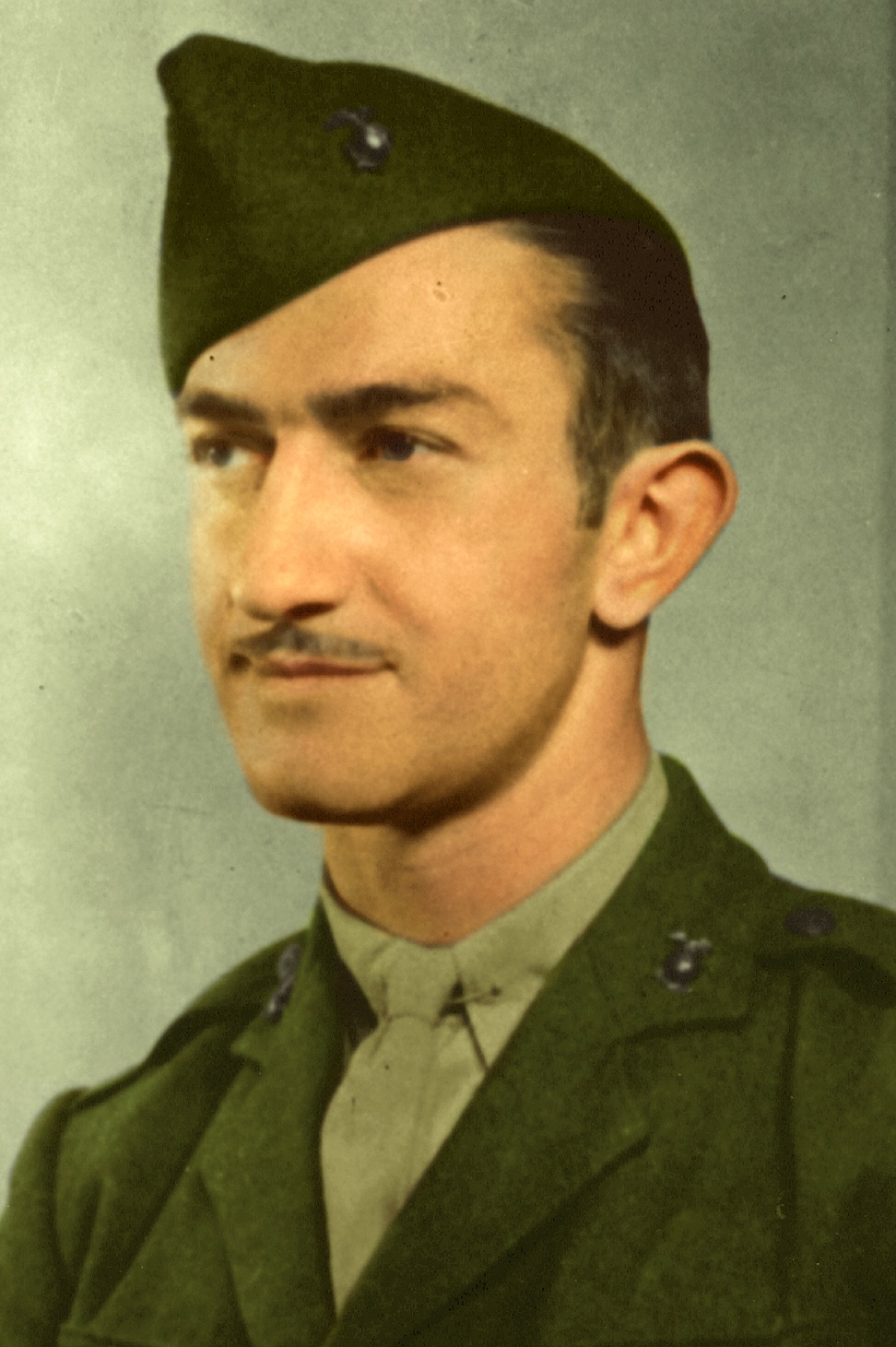
The President of the United States of America, in the name of Congress, takes pride in presenting the Medal of Honor (posthumously) to Sgt Herbert Joseph Thomas, United States Marine Corps Reserve, for extraordinary heroism and conspicuous gallantry above and beyond the call of duty while serving with the First Battalion, Third Marines, THIRD Marine Division (Reinforced), in action against enemy Japanese forces during the battle at the Koromokina River, Bougainville, Solomon Islands, on November 7, 1943.
Although several of his men were struck by enemy bullets as he led his squad through dense jungle undergrowth in the face of severe hostile machine gun fire, Sgt Thomas and his group fearlessly pressed forward into the center of the Japanese position and destroyed the crews of two machine guns by accurate rifle fire and grenades. Discovering a third gun more difficult to approach, he carefully placed his men closely around him in strategic positions from which they were to charge after he had thrown a grenade into the emplacement. When the grenade struck vines and fell back into the midst of the group, Sgt Thomas deliberately flung himself upon it to smother the explosion, valiantly sacrificing his life for his comrades. Inspired by his selfless action, his men unhesitatingly charged the enemy machine gun and, with fierce determination, killed the crew and several other nearby defenders. The splendid initiative and extremely heroic conduct of Sgt Thomas in carrying out his prompt decision with full knowledge of his fate reflect great credit upon himself and the U.S. Naval Service. He gallantly gave his life for his country.
1 Like
PFC Henry Gurke, 21, USMC (1922–1943)
Company M, 3rd Raider Battalion, 2nd Raider Regiment, I Marine Amphibious Corps
Near Empress Augusta Bay, Bougainville, Solomon Islands
November 9, 1943
Presented May 31, 1944
Posthumous
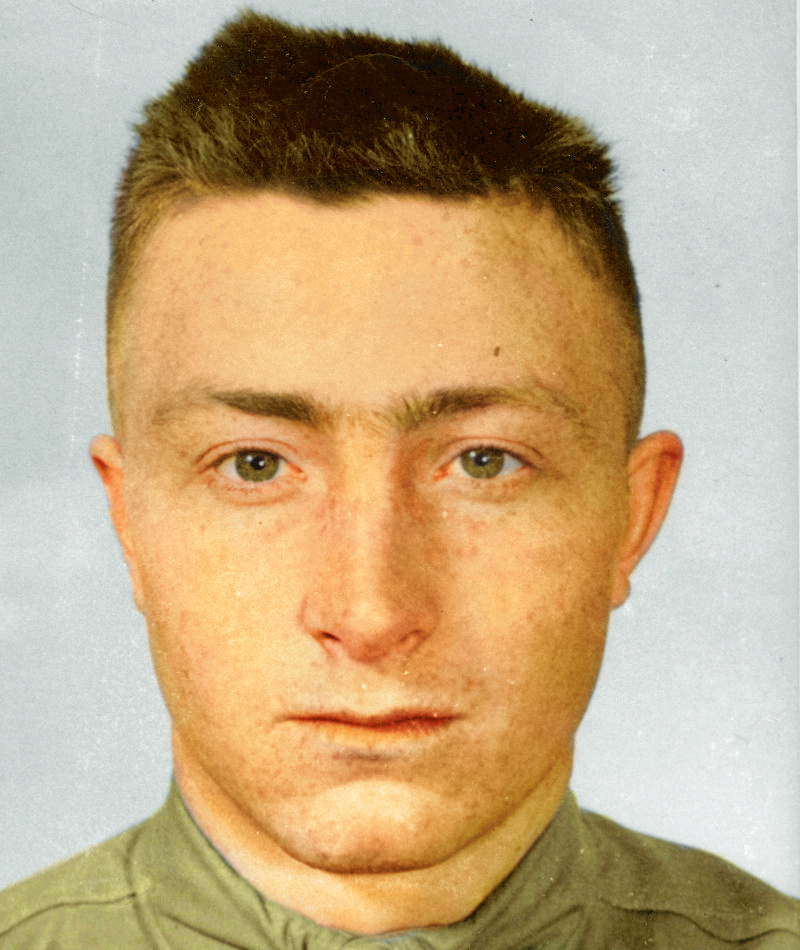
The President of the United States of America, in the name of Congress, takes pride in presenting the Medal of Honor (posthumously) to PFC Henry Gurke, United States Marine Corps, for extraordinary heroism and courage above and beyond the call of duty while serving with Company M, Third Marine Raider Battalion during action against enemy Japanese forces in the Solomon Islands area on November 9, 1943.
While his platoon was engaged in the defense of a vital road block near Empress Augusta Bay on Bougainville Island, PFC Gurke, in company with another Marine, was delivering a fierce stream of fire against the main vanguard of the Japanese. Concluding from the increasing ferocity of grenade barrages that the enemy was determined to annihilate their shallow, two-man foxhole, he resorted to a bold and desperate measure for holding out despite the torrential hail of shells. When a Japanese grenade dropped squarely into the foxhole, PFC Gurke, mindful that his companion manned an automatic weapon of superior firepower and therefore could provide more effective resistance, thrust him roughly aside and flushing his own body over the missile to smother the explosion. With unswerving devotion to duty and superb valor, PFC Gurke sacrificed himself in order that his comrade might live to carry on the fight. He gallantly gave his life in the service of his country.
1 Like
LT Maurice Lee “Footsie” Britt, 24, USA (1919–1995)
Company L, 3rd Battalion, 30th Infantry, 3rd Infantry Division
North of Mignano, Italy
November 10, 1943
Presented June 7, 1944

The President of the United States of America, in the name of Congress, takes pleasure in presenting the Medal of Honor to CAPT (Inf) Maurice Lee “Footsie” Britt, United States Army, for conspicuous gallantry and intrepidity at the risk of his life above and beyond the call of duty while serving with Company L, 3rd Battalion, 30th Infantry Regiment, 3rd Infantry Division. Disdaining enemy hand grenades and close-range machine pistol, machine-gun, and rifle fire, LT Britt inspired and led a handful of his men in repelling a bitter counterattack by approximately 100 Germans against his company positions north of Mignano, Italy, the morning of November 10, 1943.
During the intense firefight, LT Britt’s canteen and field glasses were shattered; a bullet pierced his side; his chest, face, and hands were covered with grenade wounds. Despite his wounds, for which he refused to accept medical attention until ordered to do so by his battalion commander following the battle, he personally killed five and wounded an unknown number of Germans, wiped out one enemy machine-gun crew, fired five clips of carbine and an undetermined amount of M-1 rifle ammunition, and threw 32 fragmentation grenades. His bold, aggressive actions, utterly disregarding superior enemy numbers, resulted in capture of four Germans, two of them wounded, and enabled several captured Americans to escape. LT Britt’s undaunted courage and prowess in arms were largely responsible for repulsing a German counterattack which, if successful, would have isolated his battalion and destroyed his company.
1 Like
PFC Floyd K. Lindstrom, 31, USA (1912–1944)
Company H, 7th Infantry Regiment, 3rd Infantry Division
Near Mignano, Italy
November 11, 1943
Presented April 27, 1944
Posthumous
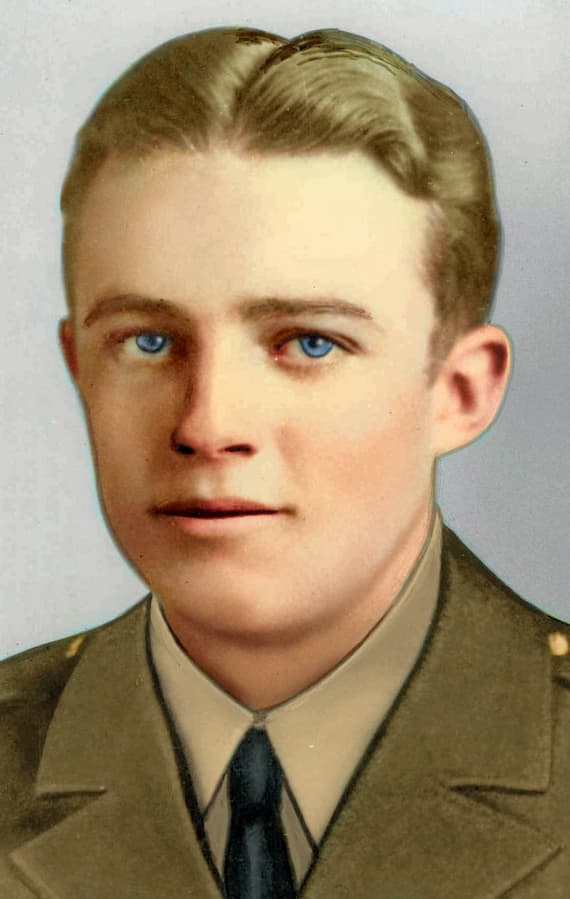
The President of the United States of America, in the name of Congress, takes pride in presenting the Medal of Honor (posthumously) to PFC Floyd K. Lindstrom (ASN: 37349634), United States Army, for conspicuous gallantry and intrepidity at risk of life above and beyond the call of duty while serving with Company H, 2nd Battalion, 7th Infantry Regiment, 3rd Infantry Division.
On November 11, 1943, this soldier’s platoon was furnishing machine-gun support for a rifle company attacking a hill near Mignano, Italy, when the enemy counterattacked, forcing the riflemen and half the machine-gun platoon to retire to a defensive position. PFC Lindstrom saw that his small section was alone and outnumbered five-to-one, yet he immediately deployed the few remaining men into position and opened fire with his single gun. The enemy centered fire on him with machine gun, machine pistols, and grenades. Unable to knock out the enemy nest from his original position, PFC Lindstrom picked up his own heavy machinegun and staggered 15 yards up the barren, rocky hillside to a new position, completely ignoring enemy small-arms fire which was striking all around him. From this new site, only ten yards from the enemy machine gun, he engaged it in an intense duel. Realizing that he could not hit the hostile gunners because they were behind a large rock, he charged uphill under a steady stream of fire, killed both gunners with his pistol and dragged their gun down to his own men, directing them to employ it against the enemy. Disregarding heavy rifle fire, he returned to the enemy machine-gun nest for two boxes of ammunition, came back and resumed withering fire from his own gun. His spectacular performance completely broke up the German counterattack. PFC Lindstrom demonstrated aggressive spirit and complete fearlessness in the face of almost certain death.
1 Like
CAPT John Philip Cromwell, 42, USN (1901–1943)
USS Sculpin (SS-191)
Off Truk Island, South Pacific
November 19, 1943
Presented April 24, 1946
Posthumous
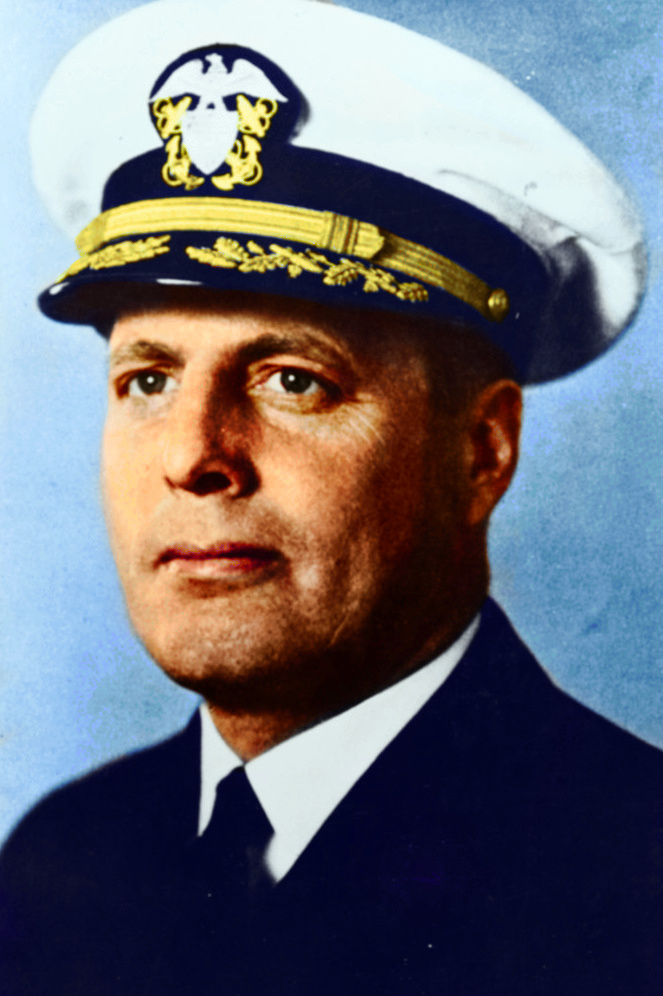
The President of the United States of America, in the name of Congress, takes pride in presenting the Medal of Honor (posthumously) to CAPT John Philip Cromwell (NSN: 0-58950), United States Navy, for conspicuous gallantry and intrepidity at the risk of his life above and beyond the call of duty as Commander of a Submarine Coordinated Attack Group with Flag in the USS SCULPIN (SS-191), during the Ninth War Patrol of that vessel in enemy-controlled waters off Truk Island, November 19, 1943.
Undertaking this patrol prior to the launching of our first large-scale offensive in the Pacific, CAPT Cromwell, alone of the entire Task Group, possessed secret intelligence information of our submarine strategy and tactics, scheduled fleet movements and specific attack plans. Constantly vigilant and precise in carrying out his secret orders, he moved his underseas flotilla inexorably forward despite savage opposition and established a line of submarines to southeastward of the main Japanese stronghold at Truk. Cool and undaunted as the submarine, rocked and battered by Japanese depth-charges, sustained terrific battle damage and sank to an excessive depth, he authorized the SCULPIN to surface and engage the enemy in a gunfight, thereby providing an opportunity for the crew to abandon ship. Determined to sacrifice himself rather than risk capture and subsequent danger of revealing plans under Japanese torture or use of drugs, he stoically remained aboard the mortally wounded vessel as she plunged to her death. Preserving the security of his mission at the cost of his own life, he had served his country as he had served the Navy, with deep integrity and an uncompromising devotion to duty. His great moral courage in the face of certain death adds new luster to the traditions of the U.S. Naval Service. He gallantly gave his life for his country.
1 Like
SSgt William James Bordelon, 22, USMC (1920–1943)
1st Battalion, 18th Marines – attached to 2nd Marines, 2nd Marine Division
Tarawa, Gilbert Islands
November 20, 1943
Presented June 17, 1944
Posthumous

The President of the United States of America, in the name of Congress, takes pride in presenting the Medal of Honor (posthumously) to SSgt William James Bordelon, United States Marine Corps, for valorous and gallant conduct above and beyond the call of duty as a member of an Assault Engineer Platoon of the First Battalion, Eighteenth Marines, tactically attached to the Second Marines, SECOND Marine Division, in action against the Japanese-held Atoll of Tarawa in the Gilbert Islands on November 20, 1943.
Landing in the assault waves under withering enemy fire which killed all but four of the men in his tractor, SSgt Bordelon hurriedly made demolition charges and personally put two pill boxes out of action. Hit by enemy machine-gun fire just as a charge exploded in his hand while assaulting a third position, he courageously remained in action and, although out of demolition, provided himself with a rifle and furnished fire coverage for a group of men scaling the seawall. Disregarding his own serious condition, he unhesitatingly went to the aid of one of his demolition men, wounded and calling for help in the water, rescuing this man and another who had been hit by enemy fire while attempting to make the rescue. Still refusing first aid for himself, he again made up demolition charges and single-handedly assaulted a fourth Japanese machine-gun position but was instantly killed when caught in a final burst of fire from the enemy. SSgt Bordelon’s great personal valor during a critical phase of securing the limited beachhead was a contributing factor in the ultimate occupation of the island and his heroic determination reflects the highest credit upon the U.S. Naval Service. He gallantly gave his life for his country.
1 Like
1stLt William Deane Hawkins, 29, USMCR (1914–1943)
Scout Sniper Platoon, 2nd Battalion, 2nd Marines, 2nd Marine Division
Tarawa, Gilbert Islands
November 20-21, 1943
Presented August 30, 1944
Posthumous
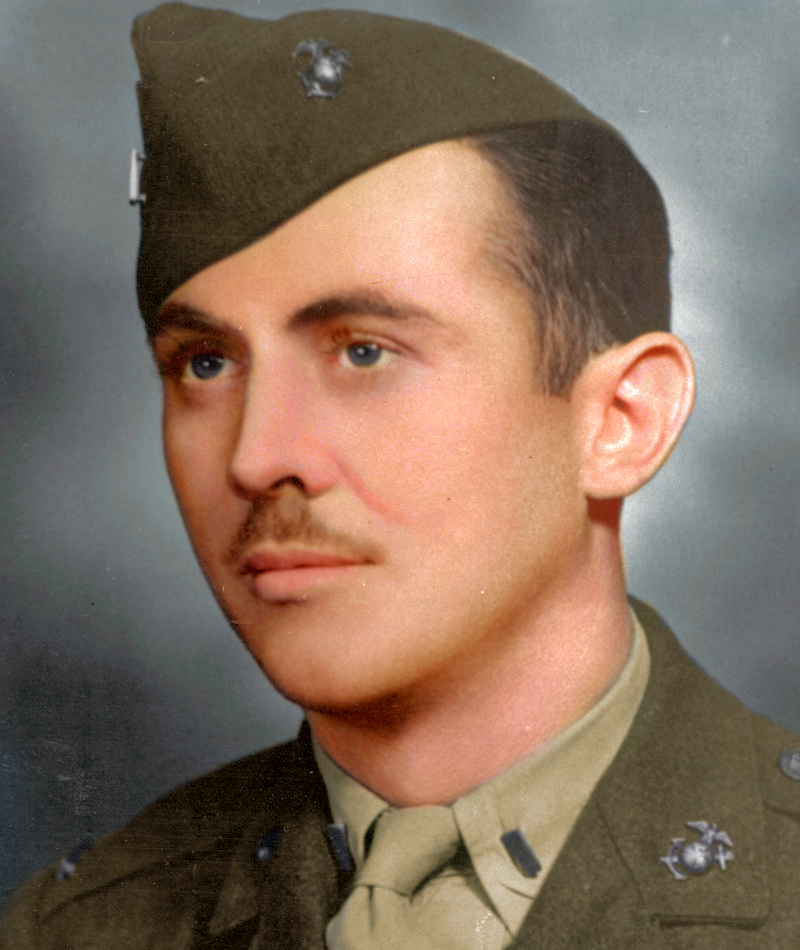
The President of the United States of America, in the name of Congress, takes pride in presenting the Medal of Honor (posthumously) to 1stLt William Deane Hawkins, United States Marine Corps Reserve, for valorous and gallant conduct above and beyond the call of duty as Commanding Officer of a Scout Sniper Platoon attached to the Second Marines, SECOND Marine Division, in action against Japanese-held Tarawa in the Gilbert Islands, November 20 and 21, 1943.
The first to disembark from the jeep lighter, 1stLt Hawkins unhesitatingly moved forward under heavy enemy fire at the end of the Betio pier, neutralizing emplacements in coverage of troops assaulting the main breach positions. Fearlessly leading his men on to join the forces fighting desperately to gain a beachhead, he repeatedly risked his life throughout the day and night to direct and lead attacks on pillboxes and installations with grenades and demolition. At dawn on the following day, 1stLt Hawkins returned to the dangerous mission of clearing the limited beachhead of Japanese resistance, personally initiating an assault on a hostile fortified by five enemy machine guns and, crawling forward in the face of withering fire, boldly fired point-blank into the loopholes and completed the destruction with grenades. Refusing to withdraw after being seriously wounded in the chest during this skirmish, 1stLt Hawkins steadfastly carried the fight to the enemy, destroying three more pillboxes before he was caught in a burst of Japanese shell fire and mortally wounded. His relentless fighting spirit in the face of formidable opposition and his exceptionally daring tactics were an inspiration to his comrades during the most crucial phase of the battle and reflect the highest credit upon the U.S. Naval Service. He gallantly gave his life for his country.
1 Like
1stLt Alexander “Sandy” Bonnyman Jr., 33, USMCR (1910–1943)
2nd Battalion Shore Party, 8th Marines, 2nd Marine Division
Tarawa, Gilbert Islands
November 20-22 [23], 1943
Presented January 22, 1947
Posthumous
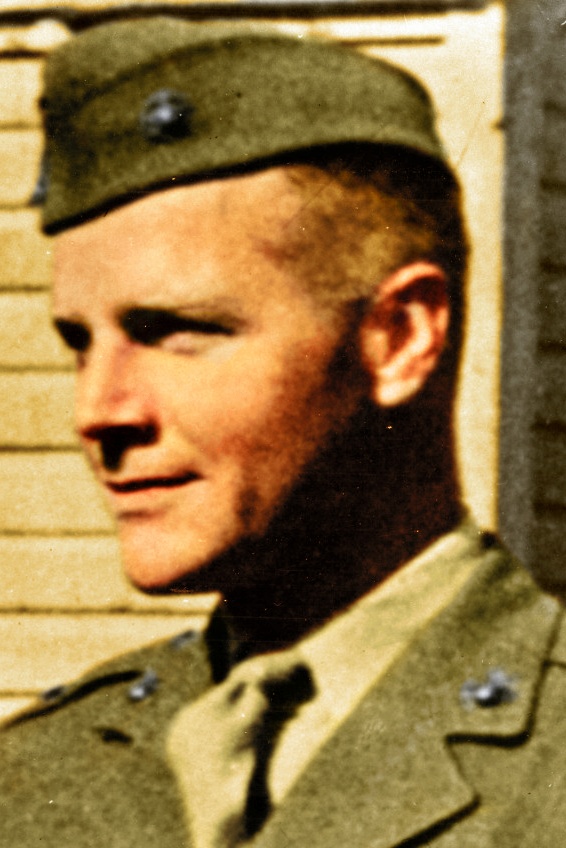
The President of the United States of America, in the name of Congress, takes pride in presenting the Medal of Honor (posthumously) to 1stLt Alexander “Sandy” Bonnyman, Jr. (MCSN 0-17525), United States Marine Corps Reserve, for conspicuous gallantry and intrepidity at the risk of his life above and beyond the call of duty as Executive Officer of the Second Battalion Shore Party, Eighth Marines, SECOND Marine Division, during the assault against enemy Japanese-held Tarawa in the Gilbert Islands, November 20-22 1943.
Acting on his own initiative when assault troops were pinned down at the far end of Betio Pier by the overwhelming fire of Japanese shore batteries, 1stLt Bonnyman repeatedly defied the blasting fury of the enemy bombardment to organize and lead the besieged men over the long, open pier to the beach and then, voluntarily obtaining flamethrowers and demolitions, organized his pioneer shore party into assault demolitionists and directed the blowing of several hostile installations before the close of D-Day. Determined to effect an opening in the enemy’s strongly organized defense line the following day, he voluntarily crawled approximately 40 yards forward of our lines and placed demolitions in the entrance of a large Japanese emplacement as the initial move in his planned attack against the heavily-garrisoned, bombproof installation which was stubbornly resisting despite the destruction early in the action of a large number of Japanese who had been inflicting heavy casualties on our forces and holding up our advance. Withdrawing only to replenish his ammunition, he led his men in a renewed assault, fearlessly exposing himself to the merciless slash of hostile fire as he stormed the formidable bastion, directed the placement of demolition charges in both entrances and seized the top of the bombproof position, flushing more than 100 of the enemy who were instantly cut down, and effecting the annihilation of approximately 150 troops inside the emplacement. Assailed by additional Japanese after he had gained his objective, he made a heroic stand on the edge of the structure, defending his strategic position with indomitable determination in the face of the desperate charge and killing three of the enemy before he fell, mortally wounded. By his dauntless fighting spirit, unrelenting aggressiveness and forceful leadership throughout three days of unremitting, violent battle, 1stLt Bonnyman had inspired his men to heroic effort, enabling them to beat off the counterattack and break the back of hostile resistance in that sector for an immediate gain of 400 yards with no further casualties to our forces in this zone. He gallantly gave his life for his country.
Col David Monroe Shoup, 39, USMC (1904–1983)
2nd Marines, 2nd Marine Division
Tarawa, Gilbert Islands
November 20-22, 1943
Presented January 22, 1945
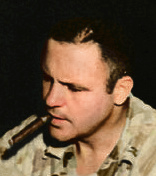
The President of the United States of America, in the name of Congress, takes pleasure in presenting the Medal of Honor to Col David Monroe Shoup (MCSN: 0-4133), United States Marine Corps, for conspicuous gallantry and intrepidity at the risk of his life above and beyond the call of duty as Commanding Officer of all Marine Corps troops in action against enemy Japanese forces on Betio Island, Tarawa Atoll, Gilbert Islands, from November 20-22, 1943.
Although severely shocked by an exploding enemy shell soon after landing at the pier and suffering from a serious, painful leg wound which had become infected, Col Shoup fearlessly exposed himself to the terrific and relentless artillery, machine-gun, and rifle fire from hostile shore emplacements. Rallying his hesitant troops by his own inspiring heroism, he gallantly led them across the fringing reefs to charge the heavily-fortified island and reinforce our hard-pressed, thinly-held lines. Upon arrival on shore, he assumed command of all landed troops and, working without rest under constant, withering enemy fire during the next two days, conducted smashing attacks against unbelievably strong and fanatically defended Japanese positions despite innumerable obstacles and heavy casualties. By his brilliant leadership, daring tactics, and selfless devotion to duty, Col Shoup was largely responsible for the final decisive defeat of the enemy, and his indomitable fighting spirit reflects great credit upon the U.S. Naval Service.
1 Like
Bonnyman’s remains were discovered in 2015, his grandson being present for the occasion.
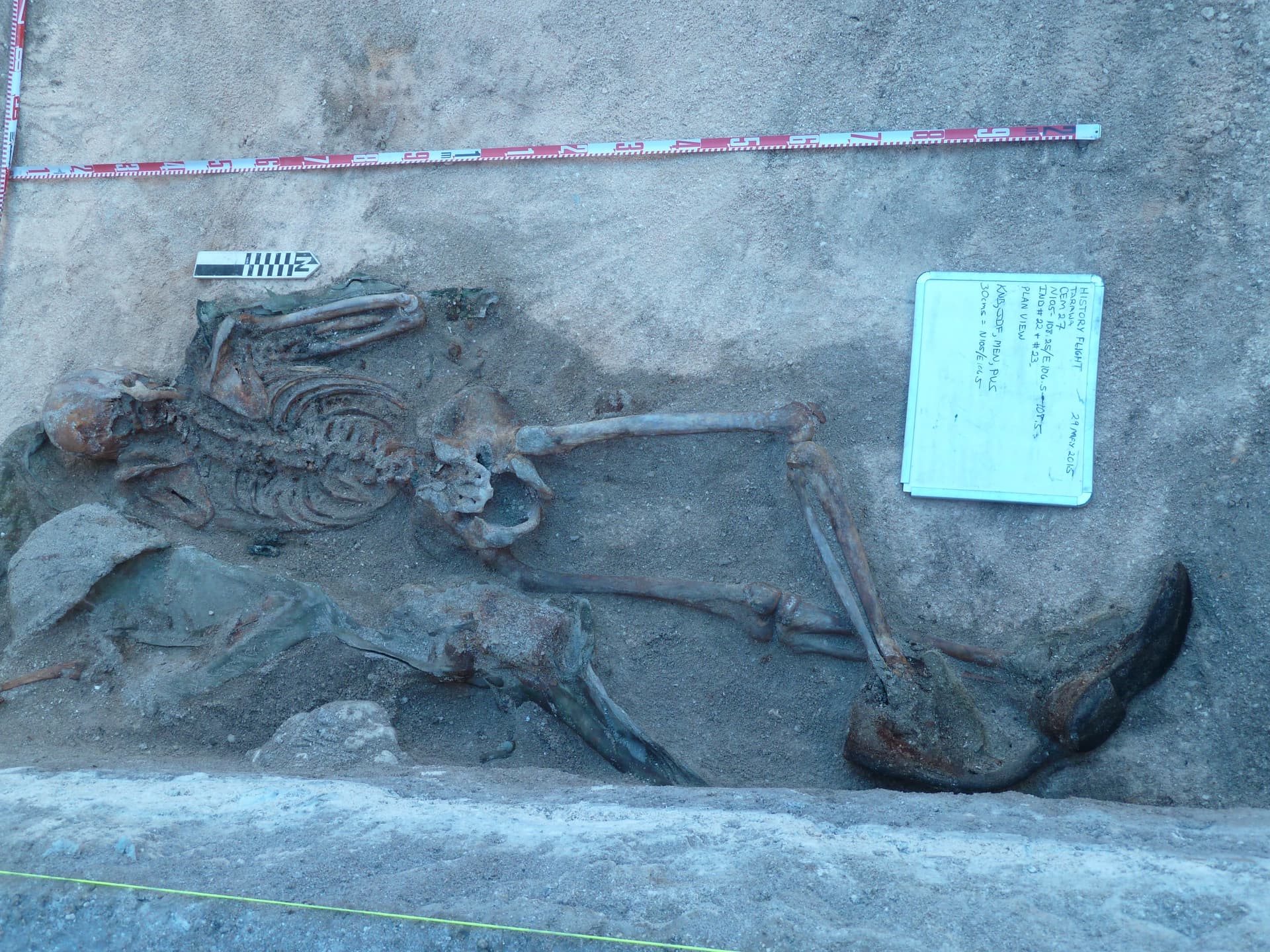
1 Like
PVT Mikio Hasemoto, 27, USA (1916–1943)
Company B, 100th Infantry Battalion (Separate) – attached to 34th Infantry Division
Cerasuolo, Italy
November 29, 1943
Presented June 21, 2000
Posthumous
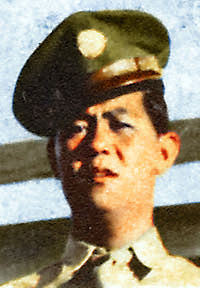
The President of the United States of America, in the name of Congress, takes pride in presenting the Medal of Honor (posthumously) to PVT Mikio Hasemoto (ASN: 30101561), United States Army, for conspicuous gallantry and intrepidity in action above and beyond the call of duty while serving with Company B, 100th Infantry Battalion (Separate), attached to the 34th Infantry Division, in action against the enemy on November 29, 1943, in the vicinity of Cerasuolo, Italy.
On that date a force of approximately 40 enemy soldiers, armed with machine guns, machine pistols, rifles, and grenades, attacked the left flank of his platoon. Two enemy soldiers with machine guns advanced forward, firing their weapons. PVT Hasemoto, an automatic rifleman, challenged these two machine-gunners. After firing four magazines at the approaching enemy, his weapon was shot and damaged. Unhesitatingly, he ran ten yards to the rear, secured another automatic rifle and continued to fire until his weapon jammed. At this point, PVT Hasemoto and his squad leader had killed approximately 20 enemy soldiers. Again, PVT Hasemoto ran through a barrage of enemy machine-gun fire to pick up an M1 rifle. Continuing their fire, PVT Hasemoto and his squad leader killed ten more enemy soldiers. With only three enemy soldiers left, he and his squad leader charged courageously forward, killing one, wounding one, and capturing another. The following day, PVT Hasemoto continued to repel enemy attacks until he was killed by enemy fire. PVT Hasemoto’s extraordinary heroism and devotion to duty are in keeping with the highest traditions of military service and reflect great credit on him, his unit, and the United States Army.
1 Like
PVT Shizuya Hayashi, 26, USA (1917–2008)
Company A, 100th Infantry Battalion (Separate) – attached to 34th Infantry Division
Cerasuolo, Italy
November 29, 1943
Presented June 21, 2000
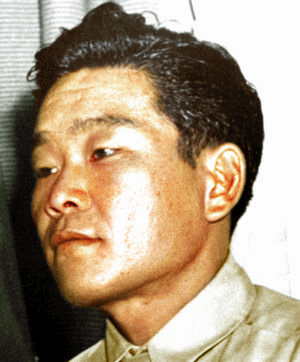
The President of the United States of America, in the name of Congress, takes pleasure in presenting the Medal of Honor to PVT Shizuya Hayashi (ASN: 30100871), United States Army, for conspicuous gallantry and intrepidity in action above and beyond the call of duty while serving with Company A, 100th Infantry Battalion (Separate), attached to the 34th Infantry Division, in action against the enemy on November 29, 1943, near Cerasuolo, Italy.
During a flank assault on high ground held by the enemy, PVT Hayashi rose alone in the face of grenade, rifle, and machine-gun fire. Firing his automatic rifle from the hip, he charged and overtook an enemy machine gun position, killing seven men in the nest and two more as they fled. After his platoon advanced 200 yards from this point, an enemy anti-aircraft gun opened fire on the men. PVT Hayashi returned fire at the hostile position, killing nine of the enemy, taking four prisoners, and forcing the remainder of the force to withdraw from the hill. PVT Hayashi’s extraordinary heroism and devotion to duty are in keeping with the highest traditions of military service and reflect great credit on him, his unit, and the United States Army.
1 Like
SSG Allan Masaharu Ohata, 25, USA (1918–1977)
Company B, 100th Infantry Battalion (Separate) – attached to 34th Infantry Division
Cerasuolo, Italy
November 29-30, 1943
Presented June 21, 2000
Posthumous
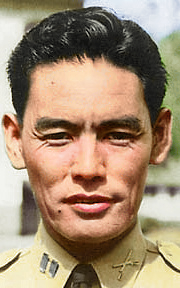
The President of the United States of America, in the name of Congress, takes pride in presenting the Medal of Honor (posthumously) to SSG Allan Masaharu Ohata (ASN: 30101888), United States Army, for conspicuous gallantry and intrepidity in action above and beyond the call of duty while serving with Company B, 100th Infantry Battalion (Separate), attached to the 34th Infantry Division, in action against the enemy on November 29 and 30, 1943, near Cerasuolo, Italy.
SSG Ohata, his squad leader, and three men were ordered to protect his platoon’s left flank against an attacking enemy force of 40 men, armed with machine guns, machine pistols, and rifles. He posted one of his men, an automatic rifleman, on the extreme left, 15 yards from his own position. Taking his position, SSG Ohata delivered effective fire against the advancing enemy. The man to his left called for assistance when his automatic rifle was shot and damaged. With utter disregard for his personal safety, SSG Ohata left his position and advanced 15 yards through heavy machine-gun fire. Reaching his comrade’s position, he immediately fired upon the enemy, killing 10 enemy soldiers and successfully covering his comrade’s withdrawal to replace his damaged weapon. SSG Ohata and the automatic rifleman held their position and killed 37 enemy soldiers. Both men then charged the three remaining soldiers and captured them. Later, SSG Ohata and the automatic rifleman stopped another attacking force of 14, killing four and wounding three while the others fled. The following day, he and the automatic rifleman held their flank with grim determination and staved off all attacks. SSG Ohata’s extraordinary heroism and devotion to duty are in keeping with the highest traditions of military service and reflect great credit on him, his unit, and the United States Army.
1 Like














